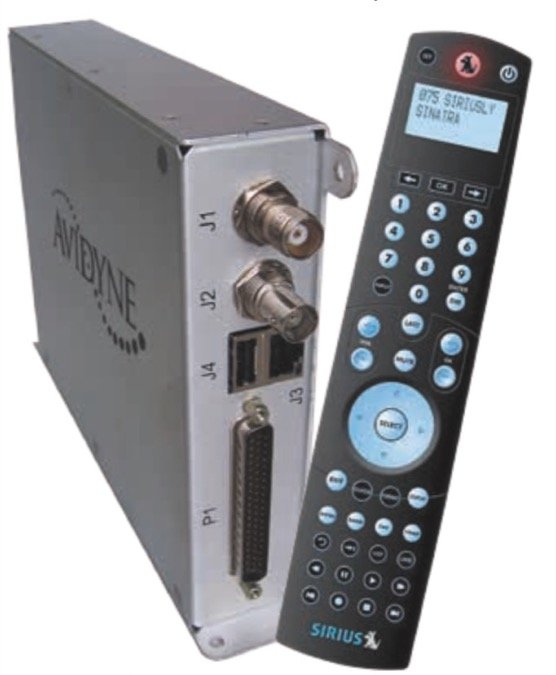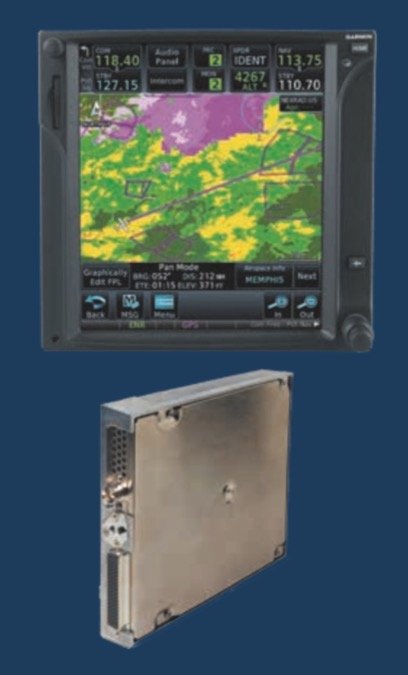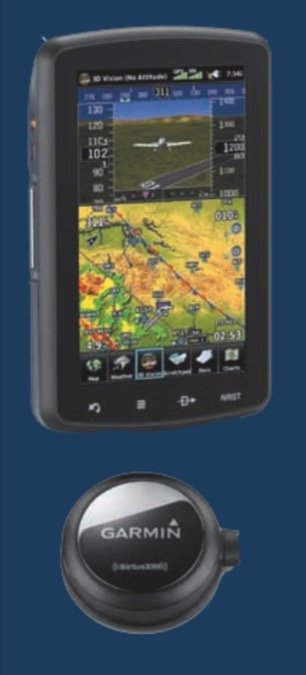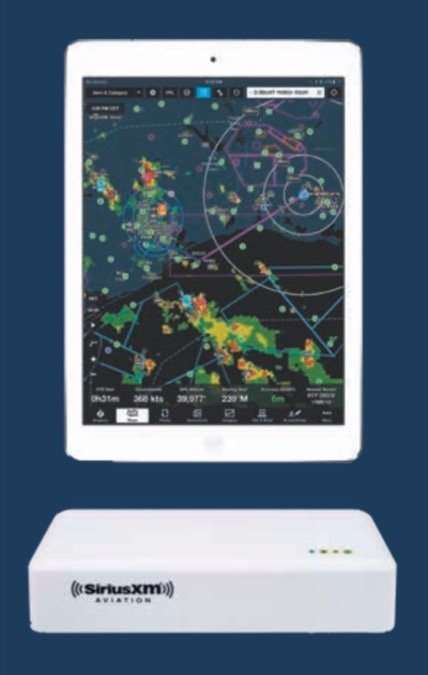If you own an Avidyne MLB700 or WSI AV300-series satellite weather receiver, you might look for a replacement. At the end of 2017, WSI—now branded The Weather Company, an IBM Business—is pulling the plug on its InFlight cockpit weather service that it delivers by SiriusXM satellites. Avidyne said it isn’t offering a replacement receiver because there’s more demand for ADS-B systems.
Is this the beginning of the end for subscription-based broadcast satellite weather as many predicted? The short answer is no. It might actually be gaining more traction, with Garmin and SiriusXM leading the charge.
ForeFlight recently added SXM weather to its Mobile app through SiriusXM’s own SXAR-1 portable receiver and Garmin is close to releasing a new SXM receiver for tablets, for the aera 660 GPS and for the G3X avionics suite. Garmin also updated its existing certified and portable receivers so they’re compatible with SiriusXM’s latest broadcast signal.

On the data side, Baron Weather Service, a longtime provider of the XM WX Satellite Weather, says it’s committed long term to the market. It continues to provide the data for legacy receivers, while focusing on newer two-way broadcast technology to fix bandwidth limitations.
WSI: Peaks And Valleys
This isn’t the first time WSI decommissioned weather receivers. In the early 2000s, it had its own datalink service provided by the twin beam Mobile Satellite Ventures system and sold the experimental AV100 receiver for EFBs and the certified AV200 for the UPS-AT MX20 MFD. Later—through reverse engineering—the AV200 worked with Garmin’s GNS530/430, but Garmin declared it an unofficial interface. The back-door serial data interface was ultimately killed when Garmin upgraded the GNS navigators to WAAS.

Third-party compatibility aside, WSI couldn’t resolve technical problems it ran into with its own satellite technology. There were coverage issues and buyers who spent upward of $5000 for a WSI installation were eventually left with proverbial paperweights.
But WSI soldiered on, signing on with Sirius Satellite Radio as the pipeline provider for the new AV300 receiver. Avidyne joined in with its own version, the MLB700.
Despite the change in satellite delivery, WSI InFlight continued to stream the same weather products for which the company earned respect, including WSI’s proprietary NOWrad radar. NOWrad is a mosaic of the U.S. Doppler network that’s been fine-tuned by WSI meteorologists for a more realistic depiction of precipitation. We’ve appreciated the high-quality graphics and reliability of the data.
While WSI regrouped, Garmin was setting a brisk pace. It took the market by storm with the GPSMAP396 portable GPS, which had the puck-shaped GXM30 XM antenna/receiver. Garmin has since built at least four more portable models, including the current aera series and two generations of the GDL69 permanent-mount XM receiver.

Multiple Broadcasts
The confusing part of the broadcast datalink weather market is there are several data transmissions, all handled by SiriusXM. In part, they differ by the way weather products are bundled and the vintage of the receiver. It’s a handful to keep straight and if the hardware isn’t confusing enough, some receivers work with WSI’s weather and some with Baron’s XM WX. Here’s why.
Before the XM and Sirius merger, there were already two streams of weather data. XM (with Baron data) occupied 2332.5 to 2345 MHz and Sirius (with WSI InFlight data) was on 2320 to 2332.5 MHz.
The merge created SiriusXM (SXM), both satellite systems remained in service and a third data stream was eventually added to support what is now SiriusXM Aviation. The latest service works with a newer generation of receivers, including the portable SXAR-1—a product launched by SiriusXM Aviation in partnership with WSI—for interface with WSI’s Pilotbrief Optima app for iPad.
The subscription chart on page 15 lists the weather products that are in the current SXM Aviation stream. While full-featured, it’s a double-edged sword, in our view. For example, there’s more bundled data in the entry-level $34.99 per-month Pilot Express than with the $34.99 per-month XM WX Aviator LT (powered by Baron Weather), but you’ll have to upgrade the receiver to take advantage of the new packages.
Hardware To Support
The Weather Company’s SXM weather service isn’t going away—only InFlight is. As the sidebar on this page shows, there are a variety of portable and permanent-mount receivers (and display interfaces), including SiriusXM’s own SXAR-1. We think this product was given a new lease on life when ForeFlight included the interface.
When we first looked at the SXAR-1 (January 2015 Aviation Consumer) it was a good performer, but we thought WSI’s Pilotbrief Optima app was lacking compared to ForeFlight, Garmin Pilot and others that have a full-up nav interface and we predicted buyers would pass on it. ForeFlight ultimately showed WSI how it’s done.

We looked (more favorably) at the SXAR-1/ForeFlight interface in the January 2017 Aviation Consumer. SiriusXM even added a ForeFlight-specific subscription package, which is $39.99 per month—a few bucks more than Pilot Express.
As for customers facing the InFlight shutdown on December 31, 2017, The Weather Company’s Matthew Taylor reasoned that the SXAR-1 portable solution would be embraced by owners with soon-to-be-orphaned Avidyne and WSI receivers because so many pilots fly with iPads. We’re not so sure about that, given the deep integration of the MLB700 on Avidyne displays, which includes the IFD-series navigators, the EX-series MFDs and the R9 retrofit flight deck.
Not everyone is sold on viewing weather data on a tablet, especially when they’ve been accustomed to using it on a big-screen panel display.
For those pilots, the HeadsUp Technologies XMD76 is compatible with Avidyne displays, but not with the newer SiriusXM Aviation subscription service. This system is common in Avidyne Entegra-equipped Cirrus models and receives Baron data. The swap will require a new antenna, too.
The option for Avidyne IFD540/440 owners is to buy a Garmin GDL69. The GDL69A-SXM has a list price of $4475 and the GDL69-SXM (no entertainment capability) is $3875. The retiring MLB700 will still receive SiriusXM entertainment programming.
Whose Decision?
Acknowledging that it’s unfortunate for owners of orphaned receivers, The Weather Company says cutting InFlight is a financial decision, plus the inability to further advance the system. It might be argued that it’s making a reasonable business decision in trimming some fat by shutting down the aging InFlight, while retaining only one data feed. Frankly, we wondered how long it would keep the two systems going.
On the other hand, there has been speculation whether SiriusXM was behind the decision in an effort to more tightly control its broadcast service. After all, the third-party receivers are licensed by SiriusXM. We asked SiriusXM’s VP of Aviation Dave Wasby for comment and he referred us to The Weather Company, but added: “At SiriusXM, we have strong partnerships with both The Weather Company and Baron as providers of our weather data.” Of course we already knew that, but we still don’t know how long SiriusXM will keep streaming Baron’s data to the herds of legacy receivers. There are a lot of first-generation Garmin GDL69 and GXM40 receivers in service. Orphaning them—especially the GDL69—would be met with sizable consumer pushback.
As some have already pointed out, Garmin holding the lion’s share of SiriusXM-licensed receivers might seem to threaten lively competition, but it can also be argued that Garmin is doing what Garmin does, and that’s aggressively pursuing market demand by pumping out the latest hardware. The Weather Company told us there are no restrictions—anyone can join the SXM market with a working receiver.
It’s hard to predict how Garmin’s pending next-gen SiriusXM receiver will sell in the flooded market of subscription-free ADS-B receivers, but if it could do both SXM and ADS-B, it might set a new benchmark for portable weather receivers. We’ll do a full report when it’s ready for prime time.
SIRIUSXM AVIATION service levels (latest-gen RECEIVERS, WSI DATA) | ||||
PACKAGE CONTENTS | Pilot Express $34.99 month | Pilot Preferred $54.99 month | Pilot Pro $99.99 month | SiriusXM Pilot for ForeFlight app $39.99 |
NEXRAD radar | ✔ | ✔ | ✔ | ✔ |
NEXRAD storm cell attributes | ✔ | ✔ | ✔ | ✔ |
Radar coverage/site status | ✔ | ✔ | ✔ | ✔ |
Lightning cloud-to-cloud, cloud-to-ground | ✔ | ✔ | ✔ | ✔ |
Temporary flight restrictions (TFRs) | ✔ | ✔ | ✔ | ✔ |
Winds aloft (including graphical depiction) | ✔ | ✔ | ✔ | ✔ |
AIRMETs/SIGMETs/PIREPs | ✔ | ✔ | ✔ | ✔ |
temperatures aloft | ✔ | ✔ | ✔ | ✔ |
Standard forecast winds | 0 hours | 0-24 hours | 0-48 hours | |
high resolution forecast winds | 0 hours | 0-3 hours | 0-24 hours | 0 hours |
metars, tafs CONUS | ✔ | ✔ | ✔ | ✔ |
metars, TAFs non-CONUS | ✔ | ✔ | ✔ | |
tropical storm tracks | ✔ | ✔ | ✔ | |
Cloud top imaging | ✔ | ✔ | ✔ | |
Surface visibility forecast | 0-1 hours | 0-3 hours | ||
graphical turbulence guidance | ✔ | |||
Freezing level/forecasting time | 0-1 hours | 0-3 hours | ||
icing NOWcast | ✔ | |||
Convective outlook | ✔ | |||
SiriusXM Radio programming | Optional | Optional | Optional | Optional |


